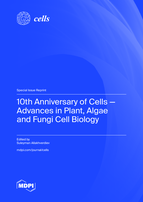10th Anniversary of Cells—Advances in Plant, Algae and Fungi Cell Biology
A special issue of Cells (ISSN 2073-4409). This special issue belongs to the section "Plant, Algae and Fungi Cell Biology".
Deadline for manuscript submissions: closed (15 December 2021) | Viewed by 58795
Special Issue Editor
Interests: photosynthesis; plant physiology; environmental stress; abiotic stress; UV radiation; photoreceptor signalling; cyanobacteria; algal; ROS; nonphotochemical quenching (NPQ); chlorophyll fluorescence; salt stress; hydrogen energy; artificial photosynthesis
Special Issues, Collections and Topics in MDPI journals
Special Issue Information
Dear Colleagues,
2021 marks the 10th anniversary of the publication of Cells. We are delighted and proud to celebrate with a series of Special Issues and events. To date, the journal has published more than 4000 papers, and the journal website attracts more than 50,000 monthly page views. We would like to express our sincerest thanks to our readers, innumerable authors, anonymous peer reviewers, editors, and all the people working in some way for the journal who have made substantial contributions for years. Without your support, we would never have made it.
To mark this important milestone, a Special Issue entitled “10th Anniversary of Cells—Advances in Plant, Algae and Fungi Cell Biology” is being launched. This Special Issue will collect, research articles, and high-quality review papers in the research fields. We kindly encourage all research groups working in Plant, Algae and Fungi Cell Biology areas to make contributions to this Special Issue.
For the details of the Cells 2021 Best Paper Awards for Anniversary Special Issues please click here (https://www.mdpi.com/journal/cells/awards.pdf/0/pdf_32_2021_2_award.pdf).

Prof. Dr. Suleyman Allakhverdiev
Guest Editor
Manuscript Submission Information
Manuscripts should be submitted online at www.mdpi.com by registering and logging in to this website. Once you are registered, click here to go to the submission form. Manuscripts can be submitted until the deadline. All submissions that pass pre-check are peer-reviewed. Accepted papers will be published continuously in the journal (as soon as accepted) and will be listed together on the special issue website. Research articles, review articles as well as short communications are invited. For planned papers, a title and short abstract (about 100 words) can be sent to the Editorial Office for announcement on this website.
Submitted manuscripts should not have been published previously, nor be under consideration for publication elsewhere (except conference proceedings papers). All manuscripts are thoroughly refereed through a single-blind peer-review process. A guide for authors and other relevant information for submission of manuscripts is available on the Instructions for Authors page. Cells is an international peer-reviewed open access semimonthly journal published by MDPI.
Please visit the Instructions for Authors page before submitting a manuscript. The Article Processing Charge (APC) for publication in this open access journal is 2700 CHF (Swiss Francs). Submitted papers should be well formatted and use good English. Authors may use MDPI's English editing service prior to publication or during author revisions.







